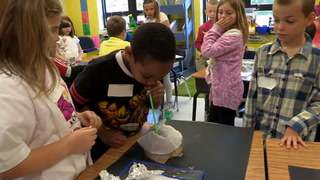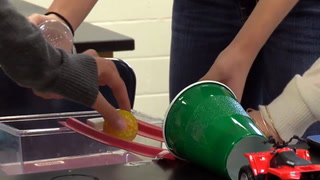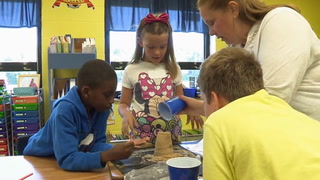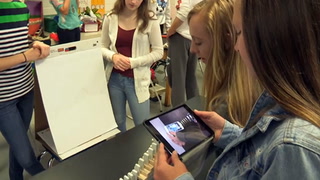Making Claims From Evidence Transcript
Becky: What were some of the things that we said how the earth could change quickly? Noah.
Noah: [?] can change the earth quickly.
Becky: Yes, people can change the earth quickly. We talked about that, right? Leila.
Leila: A rock slide.
Becky: A rock slide can definitely do that, right? So we have all kinds of different factors and phenomena in life and things that can happen and change the earth quickly, right? But then we have those things where the earth can change slowly.
My name is Becky Cope. I teach second grade at Burlington Elementary School. We're apart of the Boone County School District in Northern Kentucky.
What's something that we talked about yesterday where the earth changes slowly? Kylie.
Kylie: Erosion.
Becky: Erosion changes the earth slowly, right?
Over the last few days we've been studying the changes in the land, things that make the earth change quickly and ways that the earth can change slowly. And so today was a hands on investigation for them to really understand erosion, and maybe a way that they could even control erosion. In today's lessons, the students were going to work with how wind and water could change land. So when I first looked at this lesson, the performance expectation is to design a solution. I realized that the best way for them to understand how to do that was to plan and carry out an investigation. I did more of the planning part, the students carried it out.
Today we're going to work a little bit with our hands, okay? We're going to do an investigation and we're going to work with erosion and kind of get a better understanding of what erosion is.Okay?
With the NGSS it lends itself to students working in a group together, understanding the concepts and the practices and they understand the role of being a positive group member.
Our big question right now for investigation number one is: does wind or water cause more erosion? So right now I'm going to have the material collector come up to the tables for me.
So the cross-cutting concepts that students were working with, the main one was the stability and change. That things on Earth can happen quickly and things on Earth can happen slowly. But then within that students were also using cause and effect. And then the disciplinary core idea on Earth systems and using the earth materials.
So we're sort of scientists today and engineers.
Speaker 5: The measurer needs to measure each [?].
Becky: In the first step of the investigations, students were just working to build their sand castles and measure the sand before the wind and the water took place.
Speaker 6: Four inches - three inches.
Becky: After the recorder had that measurement taken, then one student was the wind maker and they had a straw and they blew on that sand castle. Then another student was the rain maker and they took an eye dropper and they dropped water on the sand castle to see if there was any change there. After that was completed the measurer stepped back in, they had to remeasure, see if there were any changes from the wind and water, and then they would record that.
Did it stay the same or did it change?
Noah: Change. And that one stayed the same. It just got a little crack.
Becky: It got a little crack in it. Hmm. So what do you think caused that crack?
Speaker 7: The water.
Becky: The water. The water caused that crack. How does that happen in real life? Noah.
Noah: It would push the rocks and break it.
Becky: Okay, the water can part the rocks and break it, correct? What changed in your sand castle?
Kylie: The side.
Becky: On the side of it, right? So does wind always change the same place on something, on any environment?
Speaker 7: No.
Becky: No. So on Kylie's it changed the side of it. So did your height change? Your height stayed the same, correct.
Kylie: Yeah.
Becky: But the side of her sand castle changed. So, we can't really measure that but we can observe that with our eyes, right?
So at the end of the first investigation, the students were given a question, which caused more change, the wind or the water, to the sandcastle. Practices that students were using were they were carrying out an investigation, they were analyzing data, they were using math skills within the measurement, they were constructing an argument based on their evidence.
Which one changed? Now, Braeden I heard you say water really quickly, right? But as a scientist can you just throw out answers? What do you have to do?
Braeden: Think about it.
Becky: You have to use what? Your evidence, right?
And so students had to get together within their groups and decide if the wind or the water caused more change. I asked them to go back and look for evidence that the recorder had recorded in their student journal and to use that evidence when they answered their question.
Speaker 8: This one's a little harder than that one. It's the wind.
Speaker 9: Yeah, it's the wind that blows it.
Becky: And so after that we went through the different groups and let the students share out, with the entire class, what changes they saw.
Which caused more change to your sand castles? The wind or the water?
Speaker 10: The wind did because when we blew on it some pieces were falling off it.
Becky: Okay, so you found that more pieces fell off of it with the wind than with the water.
Speaker 11: The wind is more powerful than the water.
Becky: Your wind was more powerful than the water.
So when my students first started talking about making claims, and I wanted to teach them how to make claims and use evidence in argument, we used the statement, "I think this because," so that students can show me the evidence that they used.
[Bruce?], what did you find with your group?
Speaker 12: The water did more damage to the sand castle than the wind.
Becky: The water. What was your evidence? Why do you say that?
Speaker 12: Because it was like some sand was falling off.
Becky: More sand was falling off of the water sand castle? So yours wasn't necessarily the measurements, it was more of the observation that you made your claim. Okay. So this group said wind and this group said water. Is that group wrong? Why aren't they wrong? Cole, why do you say they aren't wrong?
Cole: Because there's different people doing the blowing down.
Becky: That's a great observation, Cole. Yeah, Cole said our answers might vary, right? They might be different because maybe the wind blew harder over here at the red beach than the wind blew over here at the blue beach. So the answers can be different. But as long as you use that evidence you have and your observations and your measurements, then we can kind of discuss our arguments and our claims, right? We're going to go on and we're going to move to investigation two. Now we're going to be engineers a little bit, okay? So, in your bag, you have some different materials. You're going to design a solution. How are you going to solve the problem of wind and water erosion affecting your sand castle?
Speaker 13: For the second investigation we were trying to figure out ways to control erosion and try to help it not make the sand castles fall down and do any damage.
Becky: So investigation number two was using the same steps from investigation number one but students had to create some kind of a design solution to prevent the change to their sand castles.
Speaker 14: We're going to build a wall around the sand castle with a small top with a hole in it.
Speaker 15: If we put this hole in the sand castle like an umbrella.
Speaker 14: We could.
Becky: They were given a bag of materials and so their first task was to discuss with their group and create some kind of a solution that would prevent the wind and water from changing their sand castle during the second investigation.
Speaker 16: Eight, nine, ten. Now measure it, measurer.
Becky: They had to measure the sand castle, then they had to apply their design solutions.
Speaker 16: We need -
Becky: All right, so give it your ten puffs there, wind maker.
After they applied the wind and the water the second time, they remeasured, recorded, and then we discussed the results that they saw from that.
Speaker 17: We have five and then now three.
Becky: Did anybody see change in your sand castle? Leila, what do you think? What happened here?
Leila: First it was four inches and when we were done putting water on it it was three inches.
Becky: So what change did you see?
Leila: That when we put water on it pieces came off it.
Becky: The pieces came off it, right? When you put the water on it, the pieces came off of it.
I think that merge of the science and the engineering helped the students to have a better understanding of the change that could occur or could not occur.
You know the new bridge that we have that they've built -
So in Burlington, Kentucky we have had a new intersection being built over the last two years. It's caused lots of traffic problems and so everybody in the area knows about the new bridge that has gone in.
Speaker 18: It's by my house.
Becky: Yeah, it's by all of our houses, right. Do you think that when they built that they had to think about a solution so erosion didn't occur and that bridge doesn't fall down in a few years?
Speaker 7: Yeah.
Becky: I asked the students to think about the scientists and the engineers who worked on that bridge and what things that we talked about today and the changes in the earth and how it changes slowly would those scientists and engineers need to use in order to make sure the bridge is safe for all of us to use.
The difference between teaching science this year and teaching science last year is that I feel they're getting a deeper understanding because of using the three dimensions. The practices, the disciplinary core ideas, and the cross-cutting concepts.
Sounds good. Okay, I'm going to come back in a second and see how that works.















13 Comments
Kirsten Filippi Jan 19, 2018 3:00pm
RANU BHAT Jan 11, 2018 11:43am
Nouf AJ Sep 17, 2017 12:10pm
Danielle Rojo May 20, 2017 12:55pm
Michelle Ho May 20, 2017 11:48am